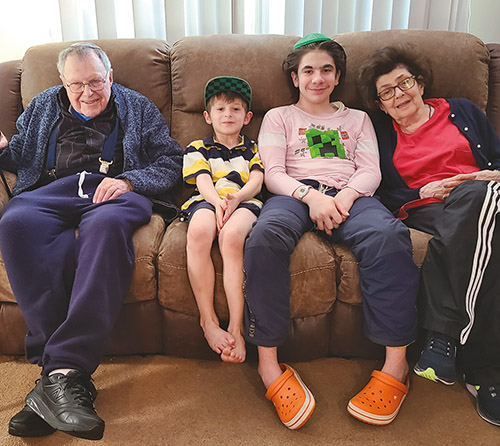

“The time is now again”—Rush, “Ceiling Unlimited.”
Time is both the enemy and the hero to triathletes.
We are racing against the clock, but the older we get, the faster we become. That’s because we are either running from something or towards it.
An intergenerational Passover Seder is the same thing, but it’s not an “either/or”—it is past present and future…all at once.
We are to remember the exodus from Egypt as if we were there, but we are remembering our childhood Seder as if we had never left. We look at our children and hope that we can give them our memories. We teach them our parents’ melodies and customs so they will inherit the Seder of our past.
My childhood was punctuated by an intergenerational Seder every year.
My father’s parents would sit on my father’s right side and I, next to them. My sisters across from us and my mother at the foot of the table.
I looked forward every year to my father’s Seder riddles, because it was my way of connecting to my father’s Seder. Some of those riddles were the ones my grandfather had asked my dad at my age.
Flash forward 40 years.
Now I am at the head of the table, with my parents on my right, my wife and children on my left…and I have my own collection of Seder riddles.
I was torn this year between giving my kids “my Seder experience” and letting them develop their own memories. I wanted them to love what I loved about the experience. I wanted them to feel that connection that flows from a village in Eastern Europe, over 150 years ago.
Last year was the first time I led the Seder, and after it was over, I said, “Eric, Stevie, I know we went from ‘Magid to meal’ in 45 minutes. I sped through to keep you guys interested and I feel like I did a rush job.”
“No…Dad, it was just the right amount of time to make it interesting and not boring,” said 14-year-old Eric. “Yeah, yeah,” piped in 7-year-old Stevie.
I was aware of the time limit of my children’s attention, this year, when on the first night, I brought out all my dad’s Seder riddles and a few of my own. I spend all year prepping for this. The adults were into it, but the kids were not. I even tried to explain how cool it was that our table was intergenerational.
We had:
My horseradish, I grew in the front yard.
My father’s Slivovitz (from the 1990s).
My father’s father’s shot glass.
My father’s mother’s wooden mixing spoon.
My mother’s mother’s, mother’s monogrammed cloth napkins.
I had tried to make my kids inherit my memories…and I had failed.
I was so frustrated that by the next afternoon, I needed to get out of the house to think. I went for a 5K run. I couldn’t use the GPS function on my watch, but I could tell time. It’s exactly 1.035 miles around my block.
I started at 5:05 p.m. I finished my three loops at 5:35:38. A 30:38 5K run was an improvement, since that distance used to take me 35 minutes.
I began my walk towards the front door, and something green caught my eye. It dawned on me, as I stared at the remaining horseradish plants in my front garden, that I was a man in search of a way back to my father’s seder table—and I was looking in the wrong place.
I now knew what I had to do. As I said, time was both my enemy and my hero.
For the second night I changed it up.
“Stevie, stand on a chair and make the kiddush.” Stevie is 9 years old and 4 foot 5, but that got his attention and he loved it. From that point on, I let him lead the seder from his Tenafly Chabad Academy Haggadah.
During the recounting of the plagues, 15-year-old Eric was losing interest, so I called him over.
“Here is a bag of plastic frogs. On my signal, unleash the plastic frogs upon thy brother Stevie.” (After which Stevie and my mom tossed the frogs across the table at each other).
This level of silliness would not have played out in the Seder of my childhood. Not because my parents would not have permitted it, but because in my past, I would not have thought to go there.
During the meal, I sat back with my Seder martini (my new Seder tradition) while my mom and dad regaled my children with stories of my juvenile antics. I wanted to know if my children were enjoying the changes I had made to the Seder, but they were too busy making their own memories to answer me.
David Roher is a USAT-certified triathlon and marathon coach. He is a multi-Ironman finisher and veteran special education teacher. He is on Instagram @David Roher140.6.
He can be reached at TriCoachDavid@gmail.com.
By David Roher









